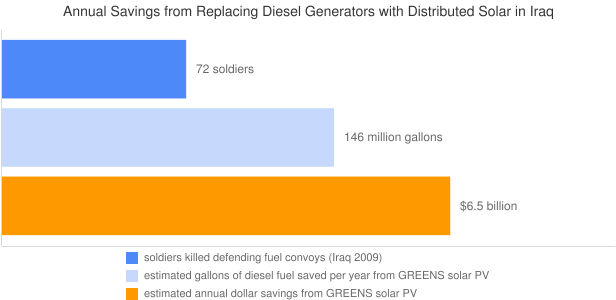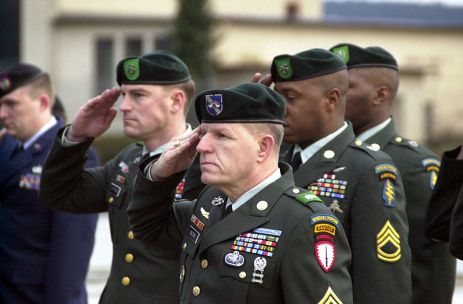This is part of a series on distributed renewable energy posted to Grist. It originally appeared on Energy Self-Reliant States, a resource of the Institute for Local Self-Reliance’s New Rules Project.
There’s no better illustration of the value of distributed renewable energy than the U.S. military. In Iraq, the 50,000 U.S. troops (as of August 2010) use 600 million gallons of fuel per year at a cost of dozens of lives of U.S. soldiers who die protecting fuel convoys and the financial cost of nearly $27 billion for fuel and security ($45 per gallon!). New distributed renewable energy systems can help combat brigades reduce fuel consumption, saving lives and money.

One Marine company — Company I, Third Battalion, Fifth Marines — field-tested the Ground Renewable Expeditionary ENergy System (GREENS) system in August 2010 and found that it saved eight gallons of fuel per day for each of the company’s 150 men. Complemented with other renewable energy systems, the Marines powered their combat operations center without using the diesel generator for eight days.
It takes approximately 200 GREENS (1,600 kilowatts of solar modules with battery storage for 300 watts of continuous power) to replace a single 60 kilowatt diesel generator, but it saved the Marine company 1,200 gallons of fuel per day. In Iraq, that fuel would have cost $45 per gallon, including transportation and security costs. That’s a savings of $54,000 in a single day. If priced at $70,000 each, the 200 GREENS will pay back in 260 days, less than 9 months:
The renewable technology that will power Company I costs about $50,000 to $70,000; a single diesel generator costs several thousand dollars. But when it costs hundreds of dollars to get each gallon of traditional fuel to base camps in Afghanistan, the investment is quickly defrayed.
If every U.S. company serving in Iraq made use of GREENS, it would reduce fuel consumption by U.S. troops by 25 percent, saving 146 million gallons of fuel and $6.5 billion per year.
There are benefits besides saved fuel and money. Marines appreciated that the solar-powered base systems are quiet, and also don’t require constant refueling. The no-fuel requirement also benefits security, as 72 U.S. soldiers died protecting convoys in Iraq in 2009.
The military provides a great illustration of the utility and cost-effectiveness of distributed generation, and one that should inform state-side strategies for energy deployment.



